Physical Physical - Tripawds Downloads
Physical Physical - Tripawds Downloads
Physical Physical - Tripawds Downloads
- No tags were found...
Create successful ePaper yourself
Turn your PDF publications into a flip-book with our unique Google optimized e-Paper software.
Recognition and control of acute pain in the earlystages is important, as undermanaged acute pain has ahigher likelihood of incomplete resolution, therefore,resulting in chronic pain. 2the CoMMuniCAtion GAPThe patient’s inability to speak makes the task of properpain assessment challenging: the patient cannot communicateabout:• Character of pain• Location or length of pain• Whether pain exists.The veterinary professionals responsible for patientcare must, therefore, rely upon the word of the animalowner, their own clinical observations, and the variousparameters that have been documented to assess painin patients.PAin sCAles & MAnAGeMent GuiDelinesSeveral pain scoring scales and sets of pain managementguidelines have been developed for use in veterinarypatients. They can be used for serial monitoring of painlevels in hospitalized patients, which facilitates optimalpain management for an in-clinic patient, despite differentpersonnel caring for that patient throughout its stay.Obvious limitations to this approach include the factthat these parameters are affected and altered significantlyby trauma, surgery, anesthesia, pharmacologicinterventions, and the stress of being handled by veterinarypersonnel.Today’s Technician |• Simple Descriptive Scales: Canine SimpleDescriptive Pain Scale, ivapm.evetsites.net/refId,20473/refDownload.pml (case-sensitive)• Visual Rating Scales.These types of scales allow the user to grade pain asnone, mild, moderate, or severe. While relatively easy andstraightforward to use, these systems may not be verysensitive in distinguishing subtle changes in pain levels.The Visual Analog Scale (VAS; partnersagainstpain.com/printouts/A7012AS1.pdf) has been widely used inhuman medicine and has also been evaluated in severalveterinary studies. 8-11 The scale consists of a line, mostoften 100 mm long, with 2 descriptors representingextremes of pain intensity (no pain and extreme pain)at each end. Users make a mark somewhere along theline that represents the pain intensity, and the VAS isscored by measuring the distance from the “no pain”end of the line. While it has been shown to be sensitiveand reproducible, a major shortcoming of this scoringsystem is that it relies heavily on the experience andfamiliarity of the user with VAS. 9Behavior-Based Pain AssessmentA behavior-based acute pain scoring system—theGlasgow Composite Measure Pain Scale (CMPS)—was developed at the University of Glasgow, which takesPain assessment in dogs & catsAcute & Chronic PainSome scoring systems and guidelines have been shownto be useful in assessing and quantifying chronic pain,such as pain associated with osteoarthritis in dogs andcats. These systems/guidelines often rely upon questionnairesprovided to animal owners and use easily assessablebehavioral characteristics, such as activity levelsand ability to exercise, to evaluate pain:• AAHA/AAFP Pain Management Guidelines forDogs and Cats 1 : aahanet.org/publicdocuments/painmanagementguidelines.pdf• Questionnaire to Measure the Effects of ChronicPain on Health-Related Quality of Life in Dogs 3A few systems have been developed to assess acutepostsurgical pain, which may be more relevant in ahospital setting:• Subjective and Objective Measures ofPostoperative Pain in Cats 4• Canine Acute Pain Scale 5 : ivapm.evetsites.net/refId,20468/refDownload.pml (case-sensitive)• Feline Acute Pain Scale 5 : ivapm.evetsites.net/refId,20467/refDownload.pml (case-sensitive)• Acute Postsurgical Pain in Dogs and Cats 6• Scale to Evaluate Postoperative Pain in Dogs. 7Pain GradingOther systems that have been described include:Figure 1. Glasgow Composite Measure Pain Scale–Short FormMarch/April 2012 Today’s Veterinary Practice 69






